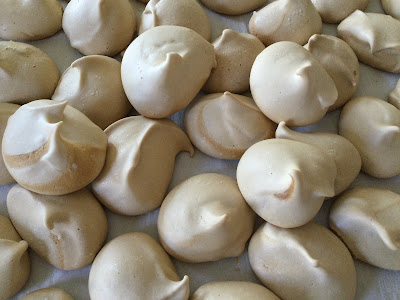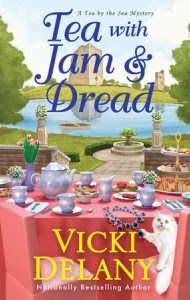A couple of weeks ago I posted my experiment replacing the eggs in Jammy Muffins with flax “eggs” made from ground flaxseed meal. The muffins were delicious and I’ll be happy to use flax “eggs” again. For today I experimented with substituting aquafaba for the eggs in meringue cookies.
First a bit of information about aquafaba: Did
you know that aquafaba comes free in every can of chickpeas? And that when you
buy a bag of dry chickpeas and boil them, you’re also making aquafaba? Why
should you care? Because aquafaba (Latin for bean water) is a great egg and egg
white substitute. Here’s another interesting (and charming) tidbit about aquafaba—its
useful egg-substitute nature was discovered in December 2014 by French tenor Joël
Roessel. That’s less than eleven years ago. Amazing. (I looked for a link to
his music so you could listen to him sing while you cook but couldn’t find one.
Je suis triste.)
Here's a nice short
history of aquafaba with recipes from Plant Based Gal. And here’s an
article by Yue He, Venkatesh Meda, Martin J.T. Reaney, and Rana Mustafa, in Science
Direct, about why aquafaba works as “a vegan, gluten and
cholesterol-free rheological additive in many food products including egg-free
mayonnaise, meringues, mousse, whipped cream, ice cream, emulsified dressings,
cocktails, and bakery products.”
You’ll find aquafaba in cans of any kind of legumes (or
by cooking them yourself), but chickpeas rank supreme for replacing whipped egg
whites. The liquid in one 15-ounce can of chickpeas should give you enough liquid for
this recipe. Aquafaba keeps in the freezer for up to 4 months.
But doesn’t whipped aquafaba taste like a
mouthful of beans? Nope, and that’s another amazing quality of
aquafaba.
Now for the experiment.
Hypothesis: If aquafaba is a
good substitute for egg whites in meringue cookies, then my family (and the neighbors)
will love the meringues and never guess that I swapped bean water for eggs.
Method: Easy. Follow the
recipe for Aquafaba Meringues.
Conclusion: It’s unanimous. Everyone
thought the meringues were fantastic.
Eggless Meringue Cookies
Adapted from Jane Black’s recipe in The New York Times
Yield: about 40 cookies
Ingredients
3/4 cup aquafaba, chilled
1/2 teaspoon cream of tartar
2/3 cup granulated sugar
2 teaspoons almond extract (we liked the cookies so much that we’re looking forward to
trying other extracts and flavorings)
Directions
Heat oven to 250 degrees F. Line two baking sheets with
parchment paper.
Pour aquafaba into a large mixing bowl (or the bowl of your
stand mixer). Beat on high (using the whisk attachment if using stand mixer)
until stiff peaks form, 10-15 minutes. Add cream of tartar and beat to
incorporate. Add sugar, one heaping tablespoon at a time, and beat until
mixture is glossy. Add extract and beat to incorporate.
Use a tablespoon to scoop mixture into mounds on the baking sheets. (The picture for this step was blurry).
Put both sheets in the oven (on different racks if necessary,
rotating them partway through baking). Bake for 1 1/2 to 2 hours, or until
meringues are dry and firm to touch. Turn oven off and let meringues sit inside
for 1 hour as oven cools.
Meringues will keep in an airtight container for 2 to 3
days.
When she’s not selling seashells by the North
Carolina seashore from her shell shop, Maureen Nash is a crime-solving sleuth
with a ghost pirate for a supernatural sidekick . . .
Maureen is still getting used to life on Ocracoke Island, learning how to play
the “shell game” of her business—and ghost whispering with the spirit of Emrys
Lloyd, the eighteenth-century Welsh pirate who haunts her shop, The Moon Shell.
The spectral buccaneer has unburied a treasure hidden in the shop’s attic that
turns out to be antique shell art stolen from Maureen’s late husband’s family
years ago.
Victor “Shelly” Sullivan and his wife Lenrose visit the shop and specifically
inquire about these rare items. Not only is it suspicious that this shell
collector should arrive around the time Maureen found the art, but Emrys
insists that Sullivan’s wife is an imposter because Lenrose is dead. A woman’s
corpse the police have been unable to identify was discovered by the Fig
Ladies, a group who formed an online fig appreciation society. They’re meeting
on Ocracoke for the first time in person and count Lenrose among their number,
so the woman can’t possibly be dead.
But Lenrose’s behavior doesn’t quite match the person the Fig Ladies interacted
with online. Now, Maureen and Emrys—with assistance from the Fig Ladies—must
prove the real Lenrose is dead and unmask her mysterious pretender before a
desperate murderer strikes again . . .
 |
| Writing as Margaret Welch |


























.png)




















Thanks for demystifying the aquafaba, Molly. I had no idea it was only discovered 11 years ago! Just in time, too.
ReplyDeleteLooking forward to trying these cookies.
That blew me away but explains why I didn't hear about it when I was a kid.
DeleteThank you for the Eggless Meringue Cookies recipe. Enjoyed learning about the uses of aquafaba as well as a bit of history behind its use. Love it when we can find a use for what is usually poured down the drain.
ReplyDelete2clowns at arkansas dot net
Glad you liked the history, Kay!
DeleteI will have to try this, thanks Molly!
ReplyDeleteYou're welcome!
DeleteHurray! Book 2 will be here around my birthday.
ReplyDeletePoints for you testing out the idea. And then very much succeeding! Necessity IS the mother of invention.
It's interesting that most bean recipes make a point of draining and rinsing the beans before proceding. I'd always thought that was due to excess salt and possibly can contamination. That can't be the case if it's ok to use the bean water for cooking.
Happy birthday in June!
DeleteIt would be interesting to compare homemade aquafaba to canned. I wonder if there'd be any difference in how it whips up or tastes? It seems like homemade would be better.
Homemade is better with so many things.
Delete